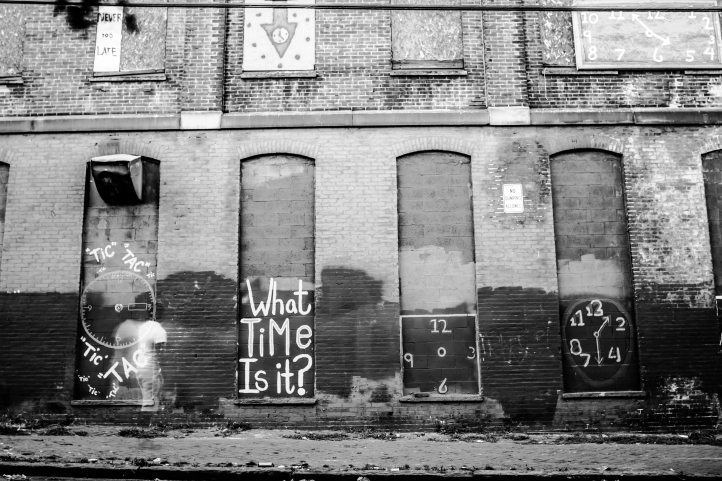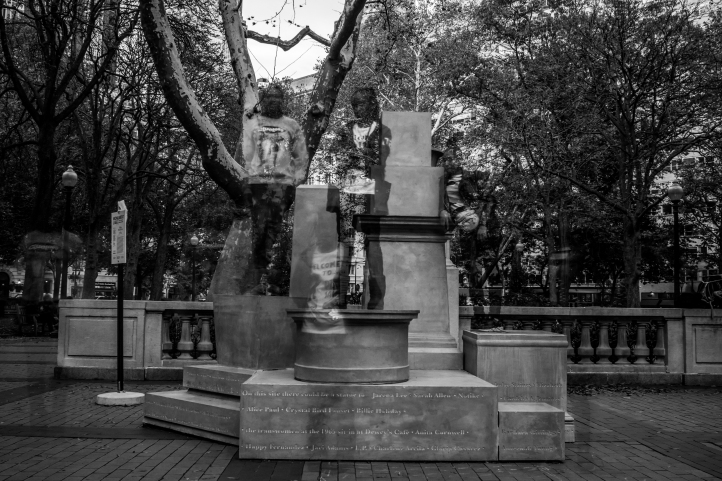From Radical Education Department
You can find another RED article by the author on monuments here.

“What time is it?” asks artist Tyree Guyton in his mural installation at Kensington, Philadelphia. A question I take to asks more than what the clocks show at the present moment. As if the name of the installation, The Times –in plural, not the singular time of the one accurate clock– asks how many times are there that order this monumental space, how many temporalities cross-cut each other at the walls of that old Kensington factory, now being a special installation within the city wide temporary public art and history project: Monument Lab.
Monument Lab: A Public Art and History Project was a temporary installation of monuments across 10 sites of Philadelphia, produced by a curatorial team and Mural Arts Philadelphia. It centered on an overarching question: “What is an appropriate monument for the current city of Philadelphia?” which is posed initially to 20 artists. It exhibits artists’ responses in the form of temporary monuments at 10 different publics sites between September 16th and November 19th, 2017. Installations accompany with research laboratories where visitors participate through proposing their appropriate monuments for the current city of Philadelphia, and shared with public on a mapped here. I think it is fair to say that Monument Lab was a majestic collective inquiry and experimentation on the ordering of public spaces of the city with art installations and citizen participations.
The project was topical as well. It opened within the heated national debate around the politics of the monuments, primarily of the confederate monuments in the Southern states and protests for the removal of Frank Rizzo monument at Philadelphia’s Thomas Paine Plaza. It provided a local venue to carry out the debate on a proper monument in a positive form of proposing new monuments that would tell the story of Philadelphia. Monument Lab Research Director Laurie Allen’s call in the project’s newspaper summarizes the historical-political starting point of the project: “Our monuments have meaning. They are city’s way of telling its story, of picking out moments in history for elevation, and for making a statement about who and what deserves to be honored and remembered. In 2017, we must recognize that the story told by our monuments is not our city’s full history. Help us elevate a richer reading of our history and move creatively toward a better future” (3).
Some of Lab monuments, such as Sharon Hayes’ “If They Should Ask” at Rittenhouse Square, marks precisely this selective historiography of the existing monuments in Philadelphia. Hayes problematizes that in the entire city there are only two monuments that are dedicated to women: French heroine Joan of Arc and Bostonian Quaker Mary Dyer. By half-scaling nine pedestals of the existing monuments in Philadelphia and writing dozens of names of public women figures from the Philadelphia-area on the pedestals, Hayes monumentalizes the absence of women’s monuments and powerfully makes the case for the exclusion of women in the public memory.

“A monument” writes Jane Golden, the executive director of Mural Arts Philadelphia, is what “commemorates something or someone, in order to uplift and keep it in public memory –an enduring symbol.“[1] Monuments are mostly[2] deliberate symbols engrained in the build environment of the city/town that encapsulates a particular past to carry it to the future. Most monuments are symbols of the state and commemorate the founding acts and heroes of the nation to remind whose heritage that land is loyal to. For critics such as Kim Dovey, “Public monuments often use the memory of a past use of force by the state to signify such future possibility.”[3] Others uplift political principles such as the human rights monuments, cultural figures or commemorate past tragedies such as genocide memorials. Each monument’s commemoration of the past has a particular purpose in the present to frame future social and political relations. Monuments’ symbolic universe dictate a certain code of conduct, a way of thinking and acting in the public, and depend on the material they are made and the surrounding social-political relations, they usually do so for long durations.
Art historian William J.T. Mitchell, in his lecture “What do Monuments Want?” observes that the desire of the monument is “to live forever, to defeat death and history.” He says that they express power and desire to immortality while at the same time; almost all of the monuments eventually scum to the blows of history and crumble. Monuments are temporal, in both sense of the term. They are made to remain intact over time, defeat death and history, but they are also products of history and the social-political relations that erect or remove them. In that sense, the time of the monument is not less frail than human time in the longue durée. Nevertheless, when it is intact and granted its demand of honor, monuments’ time poses a contrast to human temporality. Our mobility and short life span stand out against the background of monuments’ claim to stability and immortality.
Lab’s exhibit of monuments, installed for a short period of time, defeats this conventional logic of monument-time from the outset. It occupies what art critic Krauss Rosalind calls a “negative condition of the monument” where monument becomes nomadic by resigning its usual position of established place and entering into a field of “sitelessness, or homelessness, an absolute loss of place.”[4] With temporary monuments, Lab not only experiments with various monumental contents fitting for Philadelphia, but also questions the temporal logic of monumentality.
The purpose of this photography project is to contemplate on the contrast between the time of monuments and that of human beings against the background of the questions Monument Lab opens up. It can be considered as a visual dialogue with, or maybe rather an ocular ode to, the artists, curators and participants of the Monument Lab. Maybe it is even a photographic attempt to immortalize the passing of multiple times at each monumental site before they migrate to their next location. Each photograph in the series is taken with the same long exposure technique using an ND filter in daylight, which allows the photographic moment to be as long as 25 seconds. I am grateful to people who kindly accepted to be in the frames even though their faces are not really recognizable.
You can view all the images here:
[1] Monument Lab Newspaper, Issue 3, Fall 2017: 2.
[2] Its important to note that there are many kinds of monuments and here I am reflecting on only the intentional ones. For instance, there are “unintentional monuments” such as a closed factory, or natural ones such as the Uluru, aka Ayers Rock at the central desert in Australia.
[3] Dovey, Kim. Framing Places: Mediating Power in Built Form. 2 edition. London; New York: Routledge, 2007:12.
[4] Krauss, Rosalind. “Sculpture in the Expanded Field.” Visual Culture: Spaces of Visual Culture 3 (2006): 34.
